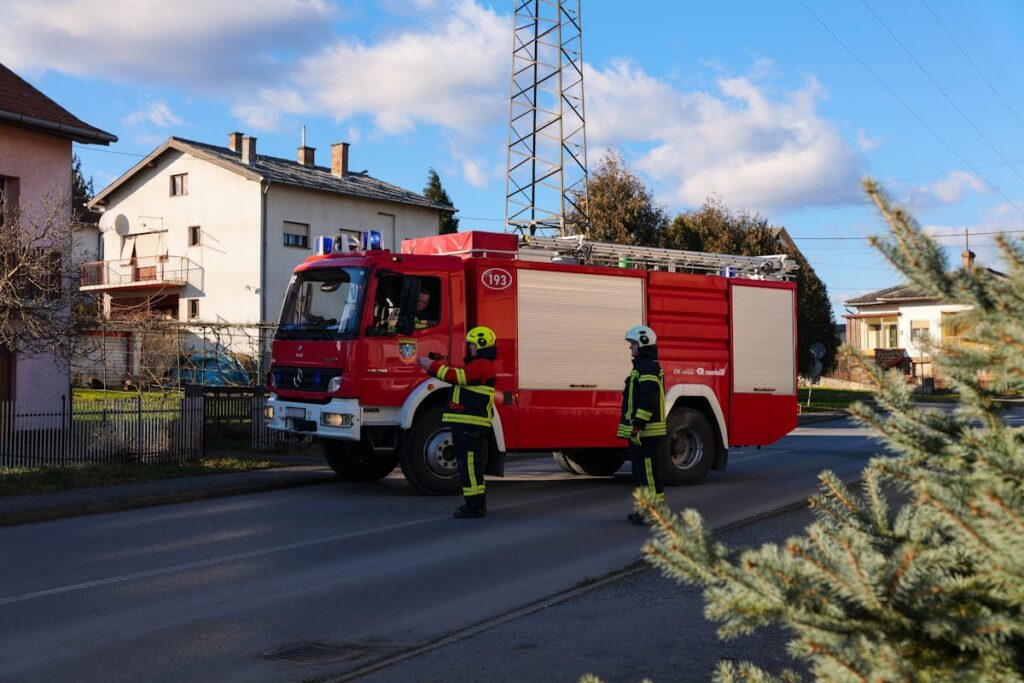The evolution of emergency medical response post-accidents has been marked by significant advancements since the late 19th century. Originally centered around basic patient transport, the field has expanded to incorporate highly trained paramedics and evidence-based interventions. Cutting-edge technologies like telemedicine and drones now play pivotal roles in enhancing care efficiency and accessibility. These innovations have revolutionized emergency medical services, yet the journey to refine response strategies continues, promising even greater improvements in patient outcomes.
The Birth of Organized Emergency Medical Services
The evolution of organized emergency medical services (EMS) can be traced back to the late 19th century, marking a pivotal shift in healthcare delivery. Historical milestones include the establishment of the first civilian ambulance services in Cincinnati and New York City in 1865 and 1869, respectively. These developments were spearheaded by key figures such as Dr. Edward Dalton, who emphasized rapid medical response. The Franco-Prussian War (1870-71) further highlighted the necessity for organized EMS, influencing future frameworks. By World War I, the concept of triage was refined, illustrating another significant historical milestone. Advances in transportation technology and medical equipment continued to shape EMS. These foundational efforts laid the groundwork for modern emergency response systems, ultimately enhancing patient survival and care.
The Role of Paramedics in Modern Medicine
Paramedics play a critical role in modern medicine, facilitated by enhanced training programs that guarantee proficiency in life-saving techniques. Evidence shows that technological advancements in medical equipment have considerably improved on-scene patient outcomes, enabling paramedics to perform complex procedures with greater accuracy. Consequently, the integration of advanced skills and technology positions paramedics as pivotal figures in pre-hospital emergency care.
Enhanced Paramedic Training Programs
In recent years, enhanced paramedic training programs have emerged as pivotal in elevating the role of paramedics within modern medicine. These programs are designed to cultivate critical skills necessary for effective emergency medical response. Central to this training is the use of simulation training, which provides a controlled environment where paramedics can hone their skills in realistic scenarios. Research indicates that simulation training considerably improves clinical decision-making and procedural proficiency. By incorporating advanced techniques and evidence-based practices, these programs guarantee that paramedics possess the competencies required to manage complex medical emergencies. As a result, paramedics are better equipped to deliver high-quality prehospital care, ultimately improving patient outcomes and reinforcing their integral role in the healthcare continuum.
Technological Advancements in Equipment
Rapid advancements in medical technology have greatly enhanced the capabilities of paramedics, directly impacting their effectiveness in emergency medical situations. Wearable technology now provides real-time monitoring of essential signs, offering paramedics immediate access to critical patient data. Devices such as advanced smartwatches can alert paramedics to irregular heart rhythms or oxygen saturation levels, enabling rapid intervention. Additionally, mobile applications have revolutionized communication and data sharing, allowing paramedics to seamlessly transmit patient information to receiving hospitals. This integration guarantees continuity of care and optimized treatment pathways. Evidence indicates that these technological tools have considerably reduced response times and improved patient outcomes. As technology continues to evolve, paramedics are increasingly equipped with sophisticated tools that enhance their critical role in modern emergency medicine.
Advances in First Aid Techniques and Training
Although the fundamental principles of first aid remain unchanged, recent advancements in techniques and training have greatly enhanced emergency medical response capabilities. Modern first aid emphasizes evidence-based methods in wound care, promoting the use of advanced hemostatic agents and pressure bandages, markedly improving hemorrhage control. Additionally, CPR techniques have evolved with a focus on high-quality chest compressions at an ideal rate and depth, increasing the survival rates in cardiac arrest situations. Rescuers receive extensive training, including scenario-based simulations, to guarantee proficiency and readiness. The integration of automated external defibrillators (AEDs) in training has further streamlined resuscitation efforts. Collectively, these developments in first aid techniques and training contribute to more effective emergency medical interventions, ultimately saving more lives in critical situations.
The Impact of Technology on Emergency Response
Recent advancements in technology have greatly enhanced emergency medical response capabilities, particularly through real-time data analysis, advanced communication tools, and automated medical devices. Real-time data analysis allows for rapid assessment of accident scenes, optimizing resource allocation and response times. Meanwhile, advanced communication tools and automated medical devices, such as portable defibrillators, facilitate immediate intervention and improve patient outcomes.
Real-Time Data Analysis
Advancements in real-time data analysis have considerably transformed emergency medical response, enhancing efficiency and accuracy. Real-time analytics allow emergency teams to process and interpret vast datasets instantaneously, leading to quicker decision-making and resource allocation. Predictive modeling plays a critical role by anticipating patient needs and potential complications based on historical data and current conditions. This approach minimizes response times and optimizes treatment plans, thereby improving patient outcomes. For instance, predictive algorithms can forecast the likelihood of trauma complications, enabling preemptive medical interventions. Additionally, real-time data integration from multiple sources, such as electronic health records and wearable technology, guarantees that emergency responders access thorough patient information. Consequently, the synergy between real-time analytics and predictive modeling represents a pivotal advancement in emergency medical response.

Advanced Communication Tools
With the integration of advanced communication tools, emergency medical response has become markedly more efficient and coordinated. Mobile applications facilitate real-time communication among first responders, hospitals, and emergency services, enabling immediate data sharing and reducing response times. These applications connect seamlessly with established communication networks, ensuring that vital information is transmitted reliably. Evidence indicates that enhanced coordination through these technologies improves patient outcomes by streamlining the process from dispatch to on-scene intervention. Communication networks also support the integration of GPS data, which optimizes route planning and resource allocation. The implementation of such tools represents a significant advancement over traditional methods, illustrating the essential role of technology in modernizing emergency response systems and enhancing their efficacy in critical situations.
Automated Medical Devices
Automated medical devices have revolutionized the landscape of emergency medical response, offering precision and efficiency in critical care scenarios. Automated defibrillators, for instance, enable rapid intervention during cardiac arrest, providing timely defibrillation that aligns with best-practice protocols. These devices are equipped with sensors and algorithms to assess heart rhythms, ensuring accurate delivery of electrical therapy. Such precision reduces the likelihood of human error and increases survival rates. Additionally, robotic triage systems are being integrated into emergency response frameworks. These systems utilize artificial intelligence to assess patient conditions quickly, prioritizing care based on severity. This innovation optimizes resource allocation, ensuring that critical patients receive prompt attention. The integration of these technologies is a demonstration of the ongoing evolution in emergency medical care.
Telemedicine: Bringing Expertise to the Scene
When an accident occurs, the immediate availability of specialized medical expertise can be critical to patient outcomes. Telemedicine plays a pivotal role by enabling remote consultations, thereby bridging the gap between on-scene responders and medical specialists. This technology facilitates the delivery of expert guidance to emergency personnel, guaranteeing that critical decisions are informed by the latest medical knowledge. Studies indicate that telemedicine can reduce response times and improve the accuracy of initial treatment protocols. By utilizing high-speed communication networks and advanced imaging capabilities, telemedicine guarantees timely diagnosis and treatment, potentially reducing morbidity and mortality rates. The implementation of telemedicine in emergency response scenarios illustrates a significant advancement in healthcare delivery, offering a promising solution for enhancing on-site medical care during emergencies.
The Rise of Drones in Emergency Situations
Drones are revolutionizing emergency response by offering rapid deployment and improved situational awareness. Equipped with advanced sensors and cameras, drones provide real-time aerial surveillance, allowing first responders to assess accident scenes efficiently. This capability enhances decision-making processes by delivering extensive overviews without the delay inherent in traditional ground assessments. Additionally, drone delivery systems have emerged as vital assets, transporting medical supplies such as defibrillators and first aid kits directly to accident sites. Evidence suggests that this technology markedly reduces response times, potentially improving patient outcomes. The integration of drones into emergency protocols represents a paradigm shift, emphasizing precision, speed, and extensive data acquisition. As regulatory frameworks evolve, drones will likely become indispensable in emergency medical response strategies.
Improving Response Times Through Innovation
Although traditional methods have long dominated emergency medical response, recent technological advancements are greatly enhancing the speed and efficiency of these operations. Response optimization is increasingly achievable through the integration of real-time data analytics and predictive algorithms, which streamline dispatch and resource allocation. Innovative partnerships between technology firms and healthcare providers are pivotal in driving these improvements. For instance, collaborations with navigation software companies facilitate quicker route mapping, reducing arrival times considerably. Additionally, the incorporation of telemedicine in the initial response phase allows for immediate remote diagnostics, ensuring that emergency personnel are better prepared upon arrival. Empirical studies demonstrate a marked reduction in response times, thereby increasing survival rates and improving patient outcomes across various emergency scenarios.
Enhancing Accessibility for Remote and Underserved Areas
How can emergency medical services reach remote and underserved areas more effectively? The integration of mobile clinics and community partnerships presents a viable solution. Mobile clinics, equipped with essential medical supplies and personnel, provide on-site care, reducing travel time to distant healthcare facilities. Evidence shows that mobile units can effectively manage acute care and chronic conditions, thereby alleviating healthcare disparities. In addition, fostering community partnerships enhances local engagement and resource allocation. Collaborative efforts with local organizations and stakeholders guarantee tailored healthcare interventions, addressing specific regional needs. Research indicates that such partnerships improve the sustainability and acceptance of emergency services. By leveraging these strategies, emergency medical response systems can greatly enhance their reach and efficacy in remote and underserved locations.
Future Prospects in Emergency Medical Care
Advancements in technology and innovation are poised to revolutionize emergency medical care in the coming decades. Future trends indicate a growing integration of artificial intelligence, telemedicine, and drone technology to enhance response times and treatment efficacy. AI’s predictive analytics can optimize ambulance routing, while telemedicine facilitates remote diagnostics, essential for immediate care. Drones offer rapid delivery of medical supplies to accident sites. Evidence supports these technologies’ potential to improve outcomes considerably.
Policy implications must be considered to guarantee ethical implementation and equitable access. Regulatory frameworks must adapt to technological integration, prioritizing data security and privacy. Investment in infrastructure and training will be vital to support these advancements. Overall, these innovations promise a transformative impact on emergency medical response, enhancing efficiency and accessibility.
Frequently Asked Questions
How Do Cultural Differences Affect Emergency Medical Response?
Cultural differences influence emergency medical response by impacting cultural norms, response protocols, and resource allocation. Communication barriers can lead to misunderstandings, affecting efficiency and effectiveness. Evidence suggests adapting protocols to cultural contexts can enhance response outcomes and resource utilization.
What Legal Challenges Face Emergency Medical Responders?
Emergency medical responders confront legal challenges including liability issues, as they can be held accountable for alleged negligence. Consent challenges arise when patients are incapacitated, making it difficult to obtain informed consent, potentially leading to legal repercussions.
How Is Mental Health Support Provided to Responders After Accidents?
Emergency responders receive mental health support through structured trauma counseling programs and peer support networks. These interventions are designed to mitigate psychological distress, promoting resilience and well-being, as evidenced by numerous studies highlighting their effectiveness in reducing post-incident stress.
What Are the Ethical Considerations in Emergency Medical Response?
Ethical considerations in emergency medical response include respecting patient autonomy by obtaining informed consent when possible, and ensuring equitable resource allocation, prioritizing care based on clinical need and available resources, supported by evidence-based protocols and guidelines.
How Are Emergency Medical Services Funded Globally?
Emergency medical services globally are funded through public funding, including government budgets and taxation, and supplemented by private donations. Variances occur based on national healthcare systems, economic conditions, and policy frameworks, impacting service accessibility and efficiency.

